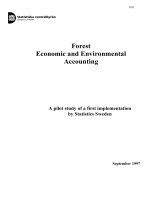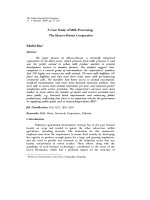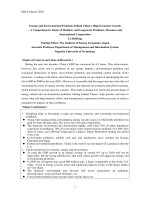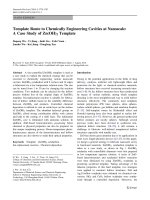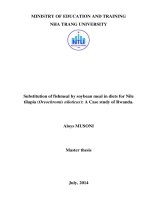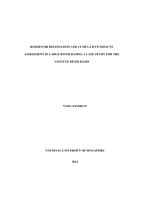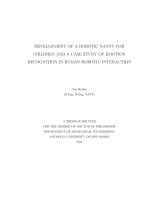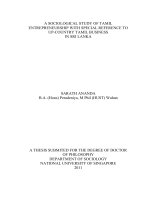A proteomics study of chemically induced cirrhosis in rat liver revealed the mechanism of thioacelamide hepatotoxicity 2
Bạn đang xem bản rút gọn của tài liệu. Xem và tải ngay bản đầy đủ của tài liệu tại đây (102.88 KB, 28 trang )
Chapter 2
Materials and Methods
Chapter 2
2.1
Materials
Analytical grade reagents were used for the preparations of general reagents.
Special reagents were obtained from:
Sigma Chemical Co. Ltd. (U.S.A.)
α-cyano-4-hydroxycinnamic acid
Ammonium carbonate
Coomassie Blue R-250
Ethylenediaminetetraacetic acid (EDTA)
Phenylmethyl sulfonyl fluoride (PMSF)
Thioacetamide (TAA)
Trifluoroacetic acid (TFA)
All common laboratory chemicals
Bio-Rad Laboratories (U.S.A.)
40% acrylamide/ bis solution in 37.5: 1 ratio
Ammonium persulfate (APS)
Dithiothreitol (DTT)
EDTA disodium dihydrate
Polyacrylamide gel reagents
Broad range protein molecular weight standards
TEMED
Urea
56
Chapter 2
PD-Quest software
Amersham Pharmacia Biotech (Sweden)
Agarose (USB)
3-[(3-cholamidopropyl)dimethylammonio]-1-propanesulfonate (CHAPS)
Immobilized pH gradient (IPG) strips
pH 3-10 IPG buffer
J.T.Baker (U.S.A.)
Tris(hydroxymethyl) aminomethane (Tris)
BDH Laboratory Supplies
Glycerol
Merck (Germany)
Acetic acid
Formaldehyde
Methanol
Silver nitrate
Sodium carbonate
Sodium thiosulphate
Sodium dodecyl sulphate (SDS)
57
Chapter 2
Fluka Chemie (Switzerland)
Iodoacetamide (IAA)
Thiourea
EM Science (U.S.A.)
Acetonitrile
Boehringer Mannheim (Germany)
DNase
RNase
Promega (U.S.A.)
Modified porcine trypsin
PIERCE (Rockford, Bedford, MA, USA)
Coomassie® Plus Protein Assay
58
Chapter 2
2.2
Chemical induction of liver fibrosis
2.2.1
Experimental animals
8-9 weeks old male Wistar-Furth rats were purchased from Sembawang Animal
Centre, Singapore. They were housed separately in an animal room on a 12 h light-dark
cycle with free access to food and water.
These rats were kept for a week for
acclimatization prior to thioacetamide (TAA) administration.
2.2.2
Preparation of 10% thioacetamide
To prepare a 10% TAA solution, 10 g of TAA was weighed and dissolved in 100
ml of autoclaved de-ionized water. The container was wrapped up with aluminum foil
and stored at 4ºC. TAA crystals reformed during storage so just before injection, TAA
was redissolved by stirring with a magnetic stirrer.
2.2.3
Administration of TAA
TAA was administered to the rats via intraperitoneal injection. Each rat was
weighed before being injected with 300 mg/kg of TAA using the formula below: if the rat
weighs N kg, then 10% TAA to inject is 3 x N ml. Each experimental rat was injected
for 3 times per week, using a 27G 1/2 needle with at least a day’s rest in between
injections. The rats were divided into 3 groups; each group was treated for 3, 6 and 10
weeks respectively. The paired controlled animal received no treatment.
59
Chapter 2
2.2.4
Sacrifice of animals
After the final injection, the rats were left untreated for a week to clear the
circulating TAA from their systems before sacrifice. During sacrifice, the rats were
anesthetized with ether in a hood before surgery.
2.2.5
Surgical removal of liver tissue
During sacrifice, a consistent lobe of liver was surgically removed, sliced into
small pieces, stored in 1 ml cryo-vials and immediately snapped-frozen in liquid nitrogen.
Then, the tissues were transferred to -152ºC freezer for storage.
2.3
Analysis of liver histopathology
Following fixation, the liver was embedded in paraffin and sectioned. 4-µm
sections were mounted on slides and stained with Masson Trichrome stain. The tissue
sections were examined blind by a trained liver pathologist. Each section was graded
under light microscopy according to the amount of positively stained collagen. The
degree of liver fibrosis was graded according to a modified scoring system below as
reported by Ruwart et al (Ruwart et al, 1989).
Ten different fields of the liver were examined and scored. In those liver sections
with obvious nodularity, each field was examined at x4 magnifications. In those liver
60
Chapter 2
sections with little or no nodularity, each field was examined at x20 magnifications. Each
animal would have a total minimum score of 0 or maximum score of 4.
Table 2-1 The scoring scheme used in the assessment of liver histopathology
Score
Description
0
No collagen or fibrosis
1
Slightly increased collagen
2
Definite increase, without septa, generally seen as small stellate
expansions of collagen from the central zones or pericentrally in the
lobules. Septa are identified as linear collagenous extensions from
microscopic landmarks, usually terminal hepatic venules
3
Definite increase with incomplete septa (those septa which do not
interconnect with each other so as to divide the parenchyma into
separate fragments)
4
Definite increase with complete septa but thin septa (those septa
which interconnect with each other so as to divide the parenchyma
into separate fragments)
61
Chapter 2
2.4
Preparation of liver tissue lysate for 2DE
Liver tissues were kept in liquid nitrogen upon retrieval from the freezer. They
were ground with a pestle and mortar in liquid nitrogen until finely powdered. For safety
purpose, the pounding was performed in a class II cell culture hood with full laminar flow
ventilation. Subsequently, lysis buffer consisting of 7 M urea, 2 M thiourea, 4% 3-[(3cholamidopropyl)
dimethylammonio]-1-propanesulfonate
(CHAPS),
40
mM
tris(hydroxymethyl aminomethane (Tris), 1 mM PMSF (Sigma), 0.5 mg/ml DNase, and
0.5 mg/ml RNase was then added to the powder and the grinding continued until the
buffer mixed well with the tissue in powder form.
Finally, the mixture was left to thaw. Tissue lysate was then carefully taken up
with a pipette into an Eppendorf tube and subjected to ultracentrifuge for 1 h at 100, 000
x g. The resulting supernatant was retrieved and kept in -80ºC deep freezer.
62
Chapter 2
2.4.1
Preparation of lysis buffer
Lysis buffer is prepared as the following:
Table 2-2 Composition of lysis buffer for 2-D gels
Buffer components
Urea
Thiourea
CHAPS
Tris-base
H2O
Amount/Volume added
Concentration
21.021 g
7M
7.612 g
2M
2.0 g
4% w/v
0.2422 g
40 mM
50 ml
-
Aliquots of 1 ml each were transferred to an Eppendorf tube and stored at -20°C.
2.5
Protein estimation
Protein concentration was estimated using Coomassie® Plus assay kit.
This kit is
compatible with the high concentration of urea and thiourea used in the lysis buffer.
Concentration of protein was estimated by measuring the adsorbance at 595 nm, using
BSA to establish a standard curve.
63
Chapter 2
2.6
Two-dimensional gel electrophoresis (2-DE)
2.6.1
First dimension - isoelectric focusing (IEF)
2.6.1.1
Rehydration of dehydrated IPG strips
For rehydration, precast 18 cm long, pH 3-10 non-linear, dry immobilized pH
gradient strips (IPGs) were immersed overnight in rehydration buffer containing 7 M
urea, 2 M thiourea, 4% CHAPS, 20 mM DTT and 5% IPG buffer (pH 3-10).
This process was first performed by pipetting 340 µL of the rehydration buffer
into the ceramic strip holders. Then, the protective plastic layer of the IPG gel was
removed and the IPG gel was placed onto the strip holder with the gel-coated surface
facing down, so that the gel surface was in contact with the rehydration buffer. To
prevent uneven rehydration, trapped air bubbles were smoothened carefully with a clean
forceps. This is followed by covering the gel with a layer of paraffin oil and a plastic
cover so as to prevent exposure of the rehydration buffer to air. This is important
because crystallation of the highly concentrated urea might occur due to evaporation of
the buffer. Rehydration should take at least 10 h and it is usually performed overnight.
Rehydration is an important step because it ensures that the dehydrated strips were
rehydrated so that they are able to adsorb solubilized protein samples during isoelectric
focusing (IEF).
64
Chapter 2
2.6.1.2
Preparation of rehydration buffer
Rehydration buffer was prepared according to the Composition below. Aliquots
of 1 ml each were transferred to an Eppendorf tube and stored at -20°C.
Buffer components
Amount/Volume added
Concentration
Urea
21.021 g
7M
Thiourea
7.612 g
2M
CHAPS
2.0 g
4% w/v
Bromephenol blue
Trace
-
50 ml
-
H2O
Table 2-3 Composition of rehydration buffer for rehydration of IPG strips
2.6.1.3
Isoelectric focusing (IEF)
All IEF experiments were performed with Amersham Pharmacia IPGphor machines. IPG
gel rehydrated overnight was first rinsed by being immersed into a clean cylinder of
purified water.
The strip was then blotted dry with a piece of clean filter paper and
transferred to a universal strip holder with the gel-coated surface facing up. This is
followed by placing a sample loading cup carefully near the acidic end of the IPG gel. 20
µl of rehydration buffer was carefully pipetted into the loading cup to test for any
leakages, and was discarded later after ensuring that the cup sat properly in the strip
holder.
65
Chapter 2
100 µg of protein sample in lysis buffer was made up to 20 µl with rehydration
buffer and was then pipetted carefully into the empty loading cup. Two pieces of filter
paper wetted with reversed osmosis water were placed at both the acidic and basic ends
of the strips. These two pieces of wet papers were then covered with electrodes. A layer
of paraffin oil was laid on the gel strip to prevent evaporation of buffer due to high
voltages. This was followed by placing the plastic cover on top of the setup. Finally, IEF
was conducted with the following steps:
Table 2-4 Voltage gradient applied for isoelectric focusing
Steps
Voltages (V)
Mode
Volt-Hours (V-hr)
1.
200
Step and hold
200
2.
500
Step and hold
250
3.
1000
Step and hold
500
4.
1000-8000
Gradient
2250
5.
8000
Step and hold
36000
Upon completion, the IPG strips were recovered, kept in a Pyrex glass tube and stored
immediately in a -80°C.
66
Chapter 2
2.6.2
Second dimension
2.6.2.1
Equilibration of IPG strips with SDS equilibration buffer
Before being transferred to the second dimensional SDS gel, it is necessary to
equilibrate the IPG strips in 2 steps. The first step involved reduction of the disulphide
bonds. Gel strips were placed in an equilibration buffer consisting of 6 M urea, 30%
glycerol, 2% SDS, 50 mM Tris-HCl (pH 6.8) and 1% (w/v) DTT and shaken slowly on a
rocker for 15 minutes.
This equilibration step is required because it reduced the
disulphide bonds and conditions the IPG strips with the SDS buffer system required for
the second dimensional separation.
This was followed by the alkylation step whereby the equilibration buffer was
discarded and replenished with a fresh batch of equilibration buffer made of 6 M urea,
30% glycerol, 2% SDS, 50 mM Tris-HCl (pH 8.8), and 2.5 % (w/v) iodoacetamide
(IAA). This step allowed the reduced free thiol groups of cysteines to be alkylated so as
to prevent reoxidation. This additional step replaced the reductant with iodoacetamide.
67
Chapter 2
2.6.2.2
Preparation of SDS equilibration buffers
The equilibration buffer was prepared as follows:
Table 2-5 Composition of buffer used for equilibration of IPG strips
pH 6.8 buffer
Amount/volume
pH 8.8 buffer
Amount/volume
Final
Concentration
Tris-HCl (pH 6.8,
1.0 M)
50 ml
-
50 Mm
Tris-HCl (pH 8.8,
1.5 M)
-
33.33 ml
50 mM
360.63 g
360.63 g
6M
300 ml
300 ml
30%
20 g
20 g
2%
trace
trace
-
Top up to 1 L
Top up to 1 L
Stock Solutions
Urea
Glycerol
SDS
Bromophenol
blue
H2O
68
Chapter 2
2.6.2.3
Sodium dodecyl sulfate-polyacrylamide gel electrophoresis
SDS-PAGE is a rapid method for protein separation, quantification, and characterization.
SDS, being an ionic detergent, binds to proteins at a uniform negative charge density and
denatures them. Thus, SDS-bound polypeptide is separated in the gel according to its molecular
weight alone. SDS-PAGE with the tris-glycine system (Laemlli, 1970) was chosen as the second
dimension for its unsurpassed resolution and ease of use. 10% T SDS-PAGE gels were cast as
the following composition:
Table 2-6 Composition of SDS-PAGE used for second dimensional separation
Stock solution
Volume (ml)
40% acrylamide/ bis solution in 37.5: 1 ratio
50.0
1.5 M Tris-HCl, pH 8.8
50.0
Deionized water
97.0
10% SDS
2.0
10% APS
1.0
TEMED
0.125
69
Chapter 2
2.6.2.4
Preparation of sample loading buffer
Protein samples need to be solubilized and denatured before SDS-PAGE. This
was accomplished by dissolving protein samples in the sample loading buffer. 2x sample
loading buffer was used for liquid sample and was prepared as the table below. Aliquots
of 1 ml each were transferred to Eppendorf tubes and stored in freezer at -20°C.
Table 2-7 Composition of sample loading buffer for SDS-PAGE
Ingredients
Volume (mL)
MilliQ Water
1.30
1.0 M Tris-Cl pH 6.8
1.20
Glycerol
2.00
10% (w/v) SDS
4.00
Bromophenol blue (0.1%)
1.00
β-mercaptoethanol
0.50
Total
9.50
70
Chapter 2
2.6.2.5
Preparation of electrode buffer
Tris-glycine buffer was the electrode buffer used in our SDS-PAGE experiments.
It was prepared as follows:
Table 2-8 Composition of electrode buffer used for SDS-PAGE
Ingredients
Amount/Volume
15.00 g
Tris
Glycine
1.0 g of SDS
MilliQ water
2.6.2.6
72.00 g
5.00 g
Top up to 5 L
Molecular weight standards
Broad range standard molecular weight markers (Bio-Rad) used included rabbit
skeletal muscle myosin (200 000 Da), E. Coli beta galactosidase (116, 250 Da), rabbit
muscle phosphorylase b (97 000 Da), bovine serum albumin (66 200 Da), hen egg white
ovalbumin (45 000 Da), bovine carbonic anhydrase (31 000 Da), soybean trypsin
inhibitor (21 500 Da) and hen egg white lysozyme (14 400 Da)
71
Chapter 2
2.6.2.7
Treatment of protein molecular weight markers
Molecular weight markers were mixed with 2x SDS sample loading buffer at a
ratio of 1:1 and then heated at 95°C for 5 min prior to application. About 5 µl of this
mixture was dispensed carefully onto a piece paper application strip before being
transferred to the second dimension.
2.6.2.8
Transfer of IPG strip to the second dimension
After SDS equilibration, the IPG strip was rinsed in purified water and blotted
dry before being transferred to the second dimension by gently laying the strip on top of a
SDS-PAGE gel. Protein molecular weight markers loaded on a piece of application strip
was inserted at one end of the strip. This was followed by gently dispensing 0.75%
agarose to seal the IPG strip and the paper strip to the second dimension.
2.6.2.9
SDS-PAGE running conditions
The second dimensional gel was performed using a Bio-rad Protean IIxi gel set
with the power pack set at a constant current of 30 mA per gel and the system was cooled
to 10°C with a Pharmacia LKB – MultiTemp II cool water circulator.
72
Chapter 2
2.7
Image visualization and analysis
To detect and visualize any protein spots, the 2-D gels were stained with silver.
After gel electrophoresis, the transparent gels were recovered and immediately kept in
fixing solution prior to staining to visualize protein spots. Silver staining was performed
according to Shenchenko et al. (Shenchenko et al., 1996). Silver stain can detect up to
nanogram of proteins and hence is suitable for staining 2-D gels.
2.7.1
Silver staining procedure
2-D gels were first immersed in fixing solution for 30 min before washing with
50% methanol in water for another 30 min. Then, the gels were washed again with water
for 60 min followed by sensitization with 0.02% sodium thiosulphate for 2 min. After
the gels were rinsed with water twice for 2 min each, they were incubated with chilled
0.1% w/v silver nitrate for 40 min at 4°C. After discarding the silver nitrate and rinsing
with 2 changes of water for 1 min each, the gels were developed in 0.04% formalin (35%
formaldehyde in water) in 2% sodium bicarbonate. When the desired image intensity
was attained, the developing solution was discarded and the gel incubated with 1.46%
EDTA disodium dihydrate for 10 min to stop the development.
The silver stain
procedure was completed with 3 rinses of water for 5 min each.
73
Chapter 2
2.7.2
Preparation of silver stain reagents
Reagents for silver stain were prepared as follows:
Table 2-9 Composition of reagents used in silver stain
Solutions
Ingredients
Composition
methanol
MilliiQ water
2.50 L
5.00 L
1.0 g
MilliQ water
Top up to 5.0 L
Silver Nitrate
2.5 g (0.1%)
MilliiQ water
Top up to 2.5 L
sodium carbonate
100 g (2%)
formalin
0.04%
MilliiQ water
Top up to 5.0 L
EDTA-Na2.H2O
Stop Solution
2.50 L
sodium thiosulphate
Developing Solution
5.00 L
TOTAL
Silver Nitrate
2.25 L
Methanol
Sodium Thiosulphate
250 mL (5%)
TOTAL
50% Methanol
acetic acid
MilliQ water
Fixing Solution
2.50 L (50%)
73 g
MilliiQ water
Top up to 5.0 L
74
Chapter 2
2.7.3
Image acquisition and analysis
Stained gels were scanned using a Molecular Dynamics Personal Densitometer
SI (Sunnyvale, CA, USA) at 1200 dots per inch (dpi). Images were saved and archived as
.gel format for subsequent image analysis.
Analysis of 2-D gel images for the detection of differentially expressed proteins
was performed in 2 steps. First, a visual inspection of the representative gels (controls
compared to the treated samples) was performed to identify protein spots that were
markedly different in their expression levels. This process is also called the “eye-balling”
approach. Then, a more detailed analysis of all the triplicates gels were performed using
the image analysis software, PDQuest (Bio-Rad).
75
Chapter 2
2.7.3.1
Eye-balling approach
In this analysis, visual inspection of the representative gels was performed. The
representative gel is the “best gel” chosen from the triplicate gels to represent a liver
sample. It was chosen based on good image resolution, spot sharpness and highest
number of spots. For comparison, the best gel of a control sample was paired up with its
respective treated counterpart to identify the proteins spot with markedly different
intensities.
To avoid ambiguity, only spots that were present/absent or prominently different
in intensities were chosen.
Subsequently, all the control representative gels were
collectively analyzed for spots that were consistent among the same controls. This
process was repeated for all the best gels of the treated samples. Labeled spots that were
present at least in 4 out of 6 pairs of the representative gels are chosen and labeled on a
“Master Gel”.
76
Chapter 2
2.7.3.2
PDQuest® (software analysis)
As the second step, PDQuest software was used for the subsequent image
analysis. With the reference of the master gels from visual inspection, we confirmed,
using PDQuest, the reproducibility of the spots in all the triplicate gels. In PDQuest®, a
representative or reference gel was first selected. Then, spot detection parameters were
optimized on this reference and applied to other member gels. After one or more sets of
detection parameters were created and saved, it was applied to detect spots in all gels.
After detecting spots on all gels, spots were compared across gels. A match set
was created. Match-sets are sets of gels that have been grouped together for the purpose
of qualitative and quantitative comparison. Spots on gel were then compared to spots on
every other gels in the match-set. At the same time, the intensity-volume of the spots was
determined in normalized average values. A student’s t test at 5% significance level was
later performed as an analysis set.
77
Chapter 2
2.8
Identification of protein spots
Identification of protein spots of interest was performed using matrix assisted
laser desorption/ionization – time of flight mass spectrometry (MALDI-TOF MS). First,
the proteins spots were excised and digested in-gel with trypsin. The peptides were then
extracted from the gel pieces and subject to mass-spectrometric analysis.
2.8.1
Excision of protein spots
Protein spots of interest were excised manually with a homemade plastic plunger
and transferred to a 96-well polypropylene microtitre plate. To avoid contamination from
keratin, a new pair of gloves was worn each time when performing trypsin digest. Each
excised spot was washed with 150 µl of 2.5 mM ammonium bicarbonate (NH4HCO3), in
50% acetonitrile.
overnight.
The plate was sealed with an adhesive film and stored at 4°C
Alternatively, the excised spots were washed with 150 µl of 2.5 mM
ammonium bicarbonate (NH4HCO3), in 50% acetonitrile for 3 times of 20 min each.
This washing step was critical as it allowed more efficient enzyme digestion and removal
of SDS.
78
Chapter 2
2.8.2
Reduction and alkylation of excised protein spots
The solution was replaced with a fresh aliquot and plates were incubated with
shaking for 20 min at 37°C. The washing solution was then aspirated and gel spots were
dried in a SpeedVac (Savant Instruments Inc., Halbrook, NY) for 20 min. The gel spots
were reswollen in 20 µl of solution containing 10 mM DTT/100 mM NH4HCO3 and
incubated at 56°C for 1 h. The solution was subsequently replaced with 20 µl of solution
containing 55 mM IAA/100 mM NH4HCO3 and incubated in the dark, at room
temperature for 45 min, with occasional vortexing.
Then, the liquid phase was aspirated and the gel was then washed in 100 µl of
100 mM NH4HCO3 solution for 10 min, followed by a 2-min sonication. Subsequently,
the solution was removed and the gels were dehydrated in 100 µl of 100% acetonitrile for
10 min, again, followed by a 2-min sonication. The above wash and dehydration steps
were repeated once. Finally, the batch of solution was removed and gel spots were dried
in a SpeedVac.
79

